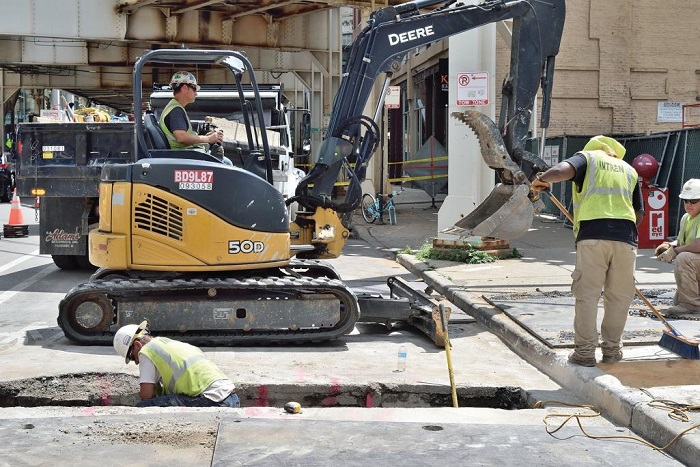
The number of trenching- and excavation-related accidents and deaths has risen over the last several years. In fact, in 2016, there were more trench collapse deaths than the previous two years combined. These specialized work environments are often necessary to run lines underground. However, the Occupational Safety and Health Administration (OSHA) has some very stringent guidelines to protect workers in this environment.
Excavations are man-made trenches, cuts, cavities or depressions in the ground that are formed by earth removal. When working in this type of environment, there are three major hazards: cave-in, confined space hazards and underground utilities.
One of OSHA’s first precautions is that there be a “competent person” on hand throughout the excavation process. A competent person is able to identify the hazards and dangerous work conditions and take action to eliminate those hazards.
According to OSHA’s eTool on Trenching and Excavation, “trenching and excavation work is dependent on these specialized employees because its highly technical nature, as well as its inherent hazards, require a greater level of training and experience than a normal worker would possess.”
Before beginning an excavation operation, the area should be properly marked. Workers should know what each marking indicates. Utilities usually use the following colors: white (proposed excavation), pink (temporary survey markings), red (electric lines and lighting cables), yellow (gas, oil, petroleum and stem lines), orange (communication lines, cables or alarm signals), blue (water), purple (reclaimed water or irrigation lines) and green (sewer and drain lines).
In the event a digger strikes a gas line, work should cease immediately. The area should be cleared, and the gas company, public, local police and fire departments should be notified. It is not safe to attempt to fill in the excavation.
Gas should be allowed to dissipate into the atmosphere, and all ignition sources should be eliminated. Equipment, vehicles and devices (even two-way radios) should be shut down. Contact the gas company and emergency services. If the gas leak is on fire, do not attempt to extinguish it unless someone’s life is in jeopardy. Don’t assume the fire is consuming all the gas. Check the area, clear personnel and barricade the danger zone.
If a fiber optic cable is struck or cut, avoid looking at the cut in the end, and contact the communication company as soon as possible. Similarly, if a water or sewer line is struck, contact the appropriate utility immediately.
Whenever an excavation is deeper than 5 feet, the sides must be shored or sloped.
Being familiar with the different types of soil and understanding required protective systems is a must to prevent accidents.
Type A soils are cohesive with an unconfined, compressive strength of 1.5 ton per square foot (tsf), or 144 kilopascals (kPa), or greater. They may include clay, silty clay, sandy clay, clay loam and, in some cases, silty clay loam and sandy clay loam. Cemented soils such as caliche and hardpan also fall in this category.
Type B soils are typically granular cohesionless soils with an unconfined compressive strength greater than 0.5 tsf (48 kPa) but less than 1.5 tsf (144 kPa). These include angular gravel (similar to crushed rock), silt, silt loam, sandy loam and in some cases, silty clay loam and sandy clay loam.
Type C soils are cohesive with an unconfined compressive strength of 0.5 tsf (48 kPa) or less and gravel, sand and loamy sand, submerged soil, soil from which water is freely seeping, or submerged rock that is not stable.
According to OSHA’s Trenching and Excavating Fact Sheet, there are several different protective systems. They are as follows:
- “Benching means a method of protecting workers from cave-ins by excavating the sides of an excavation to form one or a series of horizontal levels or steps, usually with vertical or near vertical surfaces between levels. Benching cannot be done in Type C Soil.
- “Sloping involves cutting back the trench wall at an angle inclined away from the excavation.
- “Shoring requires installing aluminum hydraulic or other types of support to prevent soil movement and cave-ins.
- “Shielding protects workers by using trench boxes or other types of supports to prevent soil cave-ins.”
When an excavation is deeper than 4 feet, it must be equipped with a safe means of exit. This may include a ladder as an escape option. Ladders used must extend 3 feet above the excavation. When working in an excavation, egress must never require travel more than 25 feet laterally to get out of the work area. Greater distances increase the risk for potential cave-in hazards.
After a dig is completed, the area should be filled in as much as possible. If any portion of an excavation is open or not completely filled, protective barriers (e.g., lighted warning devices, rope barriers, wood barricades or guardrails) must be in place.
For more information, visit osha.gov.
Credit – ECMag.com
